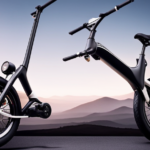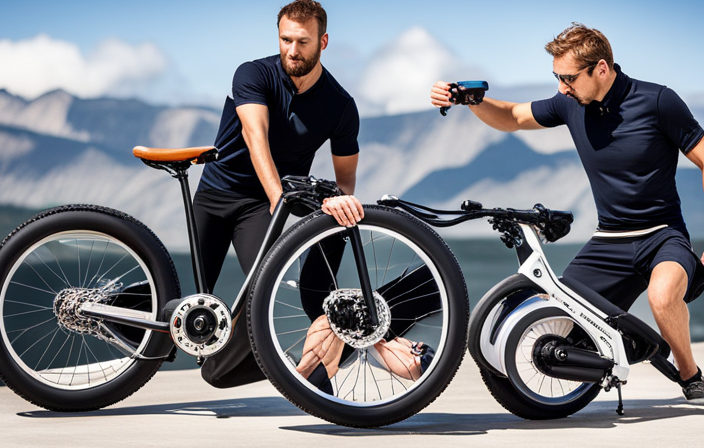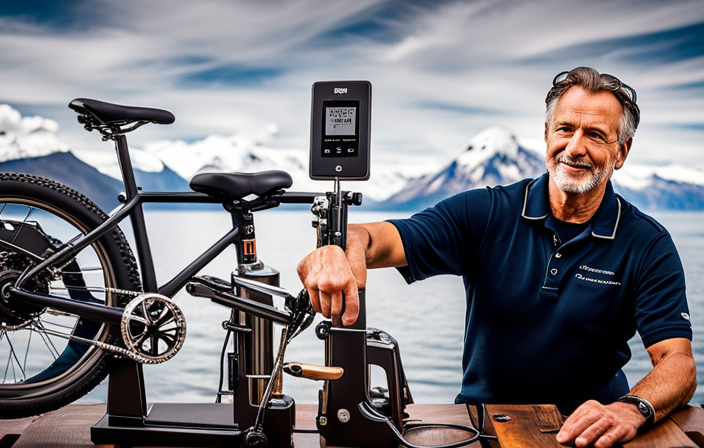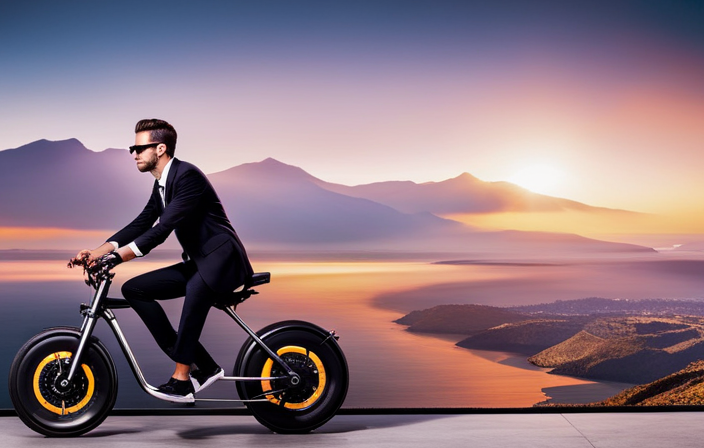When it comes to buying an electric bike, navigating the vast array of options can feel like riding through uncharted territory. But fear not, fellow adventurer, for we are here to be your compass.
Consider us your trusty guide, leading you through the winding trails of decision-making. In this article, we will equip you with the knowledge and tools to make an informed choice.
So hop on, fasten your helmet, and let’s embark on this electrifying journey together.
Key Takeaways
- Reading reviews and testimonials, and analyzing user ratings is important when buying an electric bike.
- Test riding at a local bike shop allows you to compare key aspects such as battery range, motor power, frame material, and price range.
- Personalized decision making involves assessing comfort, handling, and ride quality based on personal experience and considering specific needs and preferences.
- Protecting your investment by thoroughly evaluating options, ensuring the bike is worth the investment, and making a well-informed choice is crucial.
Determine Your Riding Needs and Style
You should determine your riding needs and style before purchasing an electric bike. Consider the type of terrain you will be riding on. Will it be mostly flat surfaces or will you be tackling hills and off-road trails? This is important because different electric bikes are designed for different terrains.
Additionally, think about your fitness level. Are you a beginner or an experienced rider looking for an extra boost? Electric bikes come with different levels of assistance, so it’s important to choose one that matches your fitness level.
Once you have determined your riding needs and style, you can move on to considering the range and battery life of the electric bike. This will ensure that you choose a bike that can keep up with your riding demands.
Consider the Range and Battery Life
When purchasing an e-bike, it’s important to keep in mind the range and battery life. These are crucial factors that will determine how far you can ride and how long the battery will last before needing to recharge. To help you understand the importance of range and battery life, here are four key points to consider:
-
Battery technology: Different e-bikes use different battery technologies, such as lithium-ion or nickel-metal hydride. Understanding the pros and cons of each will help you choose the right battery for your needs.
-
Range: The range of an e-bike refers to the distance it can travel on a single charge. Consider your typical riding habits and choose an e-bike with a range that suits your needs.
-
Battery life: The battery life refers to how long the battery will last before it needs to be replaced. Look for e-bikes with long-lasting batteries to avoid frequent replacements.
-
Charging infrastructure: Consider the availability of charging stations or access to power outlets for convenient recharging.
By considering these factors, you can ensure that your e-bike meets your range and battery life requirements.
In the next section, we will discuss how to evaluate the motor power and performance of an e-bike.
Evaluate the Motor Power and Performance
To evaluate the motor power and performance of an e-bike, it’s essential to look for indicators of speed and acceleration. The motor power determines how fast the bike can go and how quickly it can reach its top speed. Look for e-bikes with higher wattage motors, as they tend to offer better performance. Additionally, consider the type of motor, whether it’s a hub motor or a mid-drive motor. Hub motors provide a smoother and quieter ride, while mid-drive motors offer better balance and hill-climbing capabilities.
To further assess the motor power and performance, take a look at the bike’s torque rating. This indicates how much force the motor can generate, affecting the bike’s uphill performance and overall ride experience. A higher torque rating means better acceleration and power delivery.
Transitioning into the next section, it’s also important to examine the bike’s weight and frame material. By considering these factors, you can ensure a well-rounded evaluation of an electric bike’s performance and suitability for your needs.
Examine the Bike’s Weight and Frame Material
Examining the weight and frame material of an e-bike is crucial for assessing its performance and suitability. The bike’s weight plays a significant role in determining its maneuverability and ease of use. A lighter bike is generally more agile and easier to handle, especially when navigating through tight corners or crowded streets.
Additionally, the frame material is essential for durability and overall ride quality. Common frame materials for electric bikes include aluminum, steel, and carbon fiber. Each material has its strengths and weaknesses, with aluminum being lightweight and corrosion-resistant, steel being robust and affordable, and carbon fiber offering a combination of lightness and strength.
When examining the bike’s components and accessories, pay attention to the quality and reliability of the brakes, suspension, and other essential parts. These factors will ensure a safe and comfortable riding experience.
Moving on to the next section about assessing the braking system and suspension…
Assess the Braking System and Suspension
Assessing the braking system and suspension is crucial for ensuring a safe and comfortable riding experience on an e-bike.
When it comes to the braking system, you want to look for high-quality disc brakes, as they offer reliable stopping power even in wet conditions.
A well-functioning suspension is also important, especially if you plan on riding on rough terrains or uneven surfaces. Look for bikes with front suspension forks and rear suspension systems, as they help absorb shocks and provide a smoother ride. Additionally, pay attention to the adjustability of the suspension, as it allows you to customize the ride according to your preferences.
With a reliable braking system and a good suspension, you can confidently navigate different terrains with ease and enjoy a comfortable ride.
Moving on to the next section, it’s important to look into the bike’s size and fit to ensure optimal comfort and control.
Look into the Bike’s Size and Fit
When choosing an e-bike, it’s important to ensure that the bike’s size and fit are suitable for your body type and riding style.
Bike fit is crucial because if the bike doesn’t fit you properly, it can lead to discomfort, muscle strain, and even injuries.
The first thing to consider is the frame size. It should be appropriate for your height and leg length. You should be able to comfortably straddle the bike with your feet flat on the ground.
Additionally, the handlebar height and reach should be adjustable to accommodate your arm length and riding position.
It’s also essential to consider the saddle height and width, as well as the overall geometry of the bike to ensure a comfortable and efficient riding position.
Once you have determined the right size and fit, you can move on to considering the cost and budget of the e-bike.
Consider the Cost and Budget
Determining your budget is an important step in choosing an e-bike. Electric bike features vary widely, and so do their price tags. Consider what features are important to you and how much you are willing to spend.
Keep in mind that while some e-bikes may be more expensive upfront, they may require less maintenance and repair costs in the long run. Speaking of maintenance, it’s a good idea to factor in the cost of regular upkeep when budgeting for your e-bike. Maintenance tips include keeping the battery charged, cleaning and lubricating the chain, and checking tire pressure regularly.
Research the brand and warranty to ensure that you are investing in a reliable and reputable e-bike. This will give you peace of mind knowing that you are making a well-informed decision.
Research the Brand and Warranty
Take the time to research the brand and warranty of the e-bike you’re interested in to ensure you’re making a reliable and informed choice. When researching the brand, it’s important to consider their reputation in the industry. Look for well-established brands that have a positive track record of producing high-quality electric bikes. Reading customer reviews and testimonials can also give you insight into the brand’s reliability and customer satisfaction. Additionally, comparing warranties is crucial when making your decision. Look for a brand that offers a comprehensive warranty that covers not only the motor and battery, but also the frame and other components. A good warranty can provide peace of mind and protect your investment. In the next section, we will discuss the importance of reading reviews and testimonials to gather more information about the e-bike you’re considering.
Read Reviews and Testimonials
Reading reviews and testimonials can give you valuable insights about the e-bike you’re interested in and help you make an informed decision. Here are some things to consider when analyzing user ratings:
-
Comparing prices: Reviews often mention the price of the electric bike and whether it offers good value for money. This can help you determine if the bike is worth the investment or if there are better options available at a similar price point.
-
Analyzing user ratings: Reviews provide firsthand experiences of other electric bike owners. Pay attention to the overall rating and read through the comments to get a sense of the bike’s performance, durability, and any potential issues. Look for consistent feedback across multiple reviews to get a more accurate picture.
By delving into reviews and testimonials, you can gain valuable insights into the electric bike you’re considering. Once you’ve gathered this information, it’s time to visit a local bike shop and test ride options to get a feel for the bike’s performance firsthand.
Visit a Local Bike Shop and Test Ride Options
To get a better sense of the e-bike’s performance, visit a local bike shop and try out different options. Test riding an electric bike has numerous benefits that can help you make an informed decision. When you visit a local bike shop, you have the advantage of experiencing the e-bike firsthand and getting a feel for its comfort, handling, and overall ride quality. This allows you to assess whether the bike meets your specific needs and preferences. Additionally, you can test different models and compare their features side by side. To make it more engaging, here is a table comparing key aspects of different e-bike models you can try at the bike shop:
| Model | Battery Range | Motor Power | Frame Material | Price Range |
|---|---|---|---|---|
| A | 40 miles | 250W | Aluminum | $1,500 – $2,000 |
| B | 60 miles | 350W | Carbon Fiber | $2,500 – $3,000 |
| C | 30 miles | 500W | Steel | $1,000 – $1,500 |
Visiting a local bike shop and test riding different e-bike options allows you to make a well-informed decision based on your personal preferences and needs.
Frequently Asked Questions
Are there any specific maintenance requirements for electric bikes?
To properly maintain an electric bike, you should regularly check the battery, tires, and brakes. Common issues you may encounter include battery degradation, tire wear, and brake adjustments. Regular maintenance will ensure optimal performance and longevity.
Can I ride an electric bike in the rain?
Yes, you can ride an electric bike in the rain. However, it’s important to consider the riding conditions and ensure your electric bike has good waterproofing features to protect the motor, battery, and other electronic components from water damage.
Are there any legal restrictions or regulations for riding an electric bike?
Yes, there are legal restrictions and safety regulations for riding an electric bike. However, don’t let that discourage you! By following these rules, you can enjoy the benefits of an electric bike while staying safe and within the law.
How long does it take to fully charge the battery of an electric bike?
To fully charge the battery of an electric bike, it typically takes about 4 to 6 hours. However, the charging time can vary depending on the battery size and the charger used. It’s important to note that frequent fast charging can reduce the overall battery lifespan.
What are the potential drawbacks or disadvantages of owning an electric bike?
When considering the drawbacks of electric bike ownership, it’s important to note potential limitations such as limited range, longer charging times, and the need for regular maintenance. However, these disadvantages can be outweighed by the benefits of eco-friendly transportation and cost savings.
Conclusion
Congratulations! You’ve reached the end of your journey in finding the perfect electric bike. This article has provided valuable insights and considerations, acting as a compass guiding you along the way.
Remember, the right electric bike is like a trusted companion. It takes you on exhilarating adventures while being environmentally friendly.
So, gear up and let your new electric bike be the wind beneath your wings. It will propel you towards a world of excitement and sustainable travel.
Happy riding!
















